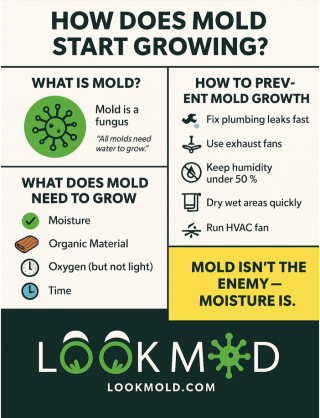Professional Mold Remediation Services
Don't Let Toxic Mold Put Your Family's Health at Risk
Stop mold damage before it spreads. Call now for a free, no-obligation estimate from a local remediation expert.
Free Estimate · Zero Obligation · Available 24/7
[Solved] How Does Mold Grow?
Let me guess — you’ve just noticed a weird musty smell in your home, maybe saw something fuzzy on the wall, or found staining that wasn’t there last month. You’re probably wondering:
How does mold even start growing in the first place?
Good question. I’ve been in the mold industry for over a decade, and most homeowners don’t think about how mold actually forms — until it’s too late. So let’s break it down, no scare tactics, just facts you can use.

What Is Mold?
Mold is a type of fungus — it’s nature’s decomposer. Outside, it breaks down dead leaves and fallen trees. Inside? It breaks down your drywall, your studs, and your wallet if left unchecked.
There are thousands of species, but the most common types I see in homes are:
- Cladosporium
- Aspergillus
- Penicillium
- Stachybotrys chartarum (aka black mold)
All of them spread through tiny spores that float in the air — everywhere — just waiting for the right conditions to settle in and multiply.
According to the CDC, mold thrives on moisture and grows on surfaces like drywall, carpet, and wood.
The EPA puts it simply: “All molds need water to grow.”
What Does Mold Need to Grow?
I tell homeowners this all the time: mold isn’t picky. If you give it water and something organic to feed on, it’ll grow.
✅ Moisture
This is the number one cause of mold growth — hands down. Whether it’s a slow drip under your sink, steam from long showers, or that small roof leak you forgot about — moisture is mold’s best friend.
✅ Organic Material
Mold loves cellulose — think drywall, wood, cardboard, even the dust in your vents.
✅ Oxygen (but not light)
Yep, mold doesn’t need sunlight. That’s why it loves attics, crawlspaces, behind walls — anywhere dark and damp.
✅ Time
You’d be surprised how fast mold moves. According to the CDC, mold can begin to grow in just 24 to 48 hours after water exposure.
“Controlling moisture is the key to preventing indoor mold growth.” — CDC
Where Does Mold Grow in Homes?
Here’s where I find mold most during inspections:
- Behind bathroom vanities where leaks go unnoticed
- In basements with poor grading or humidity issues
- Inside HVAC systems and air handlers
- On attic sheathing from roof leaks or poor ventilation
- In laundry rooms with poor air flow
- Around windows where condensation builds up
The NIOSH advises checking for visible and hidden mold in these areas regularly.
Even if everything “looks” dry, if your indoor humidity is too high, mold can still thrive.
What Triggers Mold Growth?
Sometimes it’s not a big flood. Sometimes it’s something small — and that’s what makes mold so tricky.
Here’s what to watch out for:
- Indoor humidity above 60%
- Condensation on windows or ductwork
- Slow plumbing leaks
- Water-damaged furniture or drywall
- Poor air circulation
The EPA recommends keeping humidity below 60% — ideally between 30–50%.
How Fast Can Mold Grow?
Here’s the real kicker: mold can start growing in as little as 24 hours after water exposure. That’s why acting quickly is so important.
Mold Growth Timeline:
| ⌛ Timeframe | 🔍 What’s Happening |
|---|---|
| 0–24 hours | Spores activate once they come in contact with water |
| 24–48 hours | Mold begins to grow and anchor to organic surfaces |
| 3–12 days | Colonies expand and begin to spread |
| 18–21 days | Visible mold appears — or a strong musty smell sets in |
⚠️ FEMA warns that mold damage can take hold just days after a water event.
✅ Pro Tip:
Even if you can’t see it yet, mold may already be spreading behind walls, under flooring, or inside HVAC systems.
How to Prevent Mold Growth
You don’t need chemicals or gimmicks. Here’s what I recommend:
- Fix plumbing leaks fast (don’t wait for it to “get worse”)
- Use exhaust fans in bathrooms and kitchens
- Keep humidity under 50% with a dehumidifier
- Dry out spills and wet items within 24 hours
- Run your HVAC fan to keep air circulating
- Clean and inspect ductwork
FEMA recommends removing soaked drywall and carpets within 48 hours to prevent mold colonization.
Need bathroom-specific tips? Check out how to stop mold in the bathroom.
What If You Already Have Mold?
Here’s my rule of thumb:
If it’s under 10 square feet and on a hard surface? You might be able to handle it yourself.
But if it’s:
- Inside your walls
- Caused by a leak
- On drywall or insulation
- In your HVAC system
👉 Learn when to schedule a mold inspection
The EPA recommends hiring a pro for any mold problem bigger than 10 square feet or involving HVAC.
Don’t wait for it to spread. Mold rarely stays in one place.
Final Thoughts
Mold isn’t the enemy — moisture is.
Mold is just the result of a moisture problem that wasn’t fixed fast enough. The good news? You can stay ahead of it.
Understand what mold needs to grow, know where it likes to hide, and fix water issues fast.
And if you’re already dealing with it? Don’t panic — just take action.
Explore Related Topics:
Notice an update we should make?
We strive for accuracy. Contact us here if you see incorrect or outdated info on this page.
